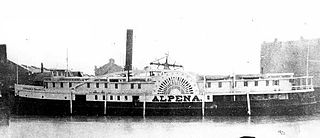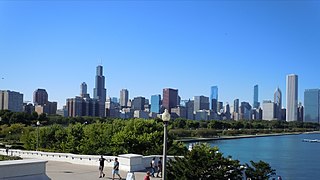
Lake Michigan is one of the five Great Lakes of North America. It is the second-largest of the Great Lakes by volume and the third-largest by surface area, after Lake Superior and Lake Huron. To the east, its basin is conjoined with that of Lake Huron through the 3+1⁄2 miles wide, 295 feet deep, Straits of Mackinac, giving it the same surface elevation as its easterly counterpart; the two are technically a single lake.
The Pere Marquette Railway operated in the Great Lakes region of the United States and southern parts of Ontario in Canada. It had trackage in the states of Michigan, Ohio, Indiana and the Canadian province of Ontario. Its primary connections included Buffalo; Toledo; and Chicago. The company was named after Père Jacques Marquette S.J. (1637–1675), a French Jesuit missionary who founded Michigan's first European settlement, Sault Ste Marie.

The PS Alpena was a sidewheel steamer built by Thomas Arnold of Gallagher & Company at Marine City, Michigan in 1866. She was operated by the Goodrich Line after being purchased from Gardner, Ward & Gallagher in April 1868. The Alpena sank in Lake Michigan in the "Big Blow" storm on October 15, 1880, with the loss of all on board.

The Ann Arbor Railroad was an American railroad that operated between Toledo, Ohio, and Elberta and Frankfort, Michigan with train ferry operations across Lake Michigan. In 1967 it reported 572 million net ton-miles of revenue freight, including 107 million in "lake transfer service"; that total does not include the 39-mile subsidiary Manistique and Lake Superior Railroad.

Chief Wawatam was a coal-fired steel ship that was based, for most of its 1911–1984 working life, in St. Ignace, Michigan. The vessel was named after a distinguished Ojibwa chief of the 1760s. In initial revenue service, the Chief Wawatam served as a train ferry, passenger ferry and icebreaker that operated year-round at the Straits of Mackinac between St. Ignace and Mackinaw City, Michigan. During the winter months, it sometimes took many hours to cross the five-mile-wide Straits, and Chief Wawatam was fitted with complete passenger hospitality spaces.
North American was a Great Lakes steamship built by the Great Lakes Engineering Works at Ecorse, Michigan, in 1913 for the Chicago, Duluth & Georgian Bay Transit Company. The vessel was launched on January 16, 1913, and was the older of two near-sister ships, the newer one being SS South American.

SS Milwaukee Clipper, also known as SS Clipper, and formerly as SS Juniata, is a retired passenger ship and automobile ferry that sailed under two configurations and traveled on all of the Great Lakes except Lake Ontario. The vessel is now docked in Muskegon, Michigan.

The SS Christopher Columbus was an American excursion liner on the Great Lakes, in service between 1893 and 1933. She was the only whaleback ship ever built for passenger service. The ship was designed by Alexander McDougall, the developer and promoter of the whaleback design.
Detroit and Cleveland Navigation Company, often abbreviated as D&C, was a shipping company on the Great Lakes.

Steamer South American was a Great Lakes steamer built by the Great Lakes Engineering Works at Ecorse, Michigan. It was built in 1913/14 for the Chicago, Duluth & Georgian Bay Transit Company. The vessel was launched on February 21, 1914 and was the newer of two near-sister ships, the older one being the North American.
SS Alabama was a steamship that served on the Great Lakes.

The history of commercial passenger shipping on the Great Lakes is long but uneven. It reached its zenith between the mid-19th century and the 1950s. As early as 1844, palace steamers carried passengers and cargo around the Great Lakes. By 1900, fleets of relatively luxurious passenger steamers plied the waters of the lower lakes, especially the major industrial centres of Chicago, Milwaukee, Detroit, Cleveland, Buffalo, and Toronto.

Goodrich Transit Line or Goodrich Steamship Line or Goodrich Transportation Company or Goodrich Transit Company was a passenger steamship line operating in the Great Lakes region, principally in Lake Michigan in the 19th and early 20th century.

The Great Lakes megalopolis consists of the group of metropolitan areas in North America largely in the Great Lakes region. It extends from the Midwestern United States in the south and west to western Pennsylvania and Western New York in the east and northward through Southern Ontario into southwestern Quebec in Canada. It is the most populated and largest megalopolis in North America.
Shepler's Mackinac Island Ferry is one of two ferry companies serving Mackinac Island, Michigan. The company has docks in Mackinaw City and St. Ignace. Shepler's provides ferry and freight service to Mackinac Island.

MV Corinthian is a cruise vessel that operates on the Great Lakes, in the Mediterranean, and around Antarctica. Summer ports of call in the Great Lakes include Toronto, Port Weller, Little Current, Mackinac Island, Houghton, Michigan, Thunder Bay and Duluth, Minnesota. She was launched in 1990, built by Cantiere Navale Ferrari-Signani in La Spezia, Italy and was operated by Renaissance Cruises and Great Lakes Cruise Company as the Renaissance IV. After Renaissance Cruises ceased operations, she was known for a time as the Clelia II.

Due to its unique geography, being made of two peninsulas surrounded by the Great Lakes, Michigan has depended on many ferries for connections to transport people, vehicles and trade. The most famous modern ferries are those which carry people and goods across the Straits of Mackinac to the car-free Mackinac Island but before the Mackinac Bridge was built, large numbers of ferries carried people and cars between the two peninsulas. Other ferries continue to provide transportation to small islands and across the Detroit River to Canada. Ferries once provided transport to island parks for city dwellers. The state's only national park, Isle Royale cannot be reached by road and is normally accessed by ferry. The largest ferries in Michigan are the car ferries which cross Lake Michigan to Wisconsin. One of these, the SS Badger is one of the last remaining coal steamers on the Great Lakes and serves as a section of US Highway 10 (US 10). The Badger is also the largest ferry in Michigan, capable of carrying 600 passengers and 180 autos.

SS Russia was an iron-hulled American Great Lakes package freighter that sank in a Lake Huron gale on April 30, 1909, near DeTour Village, Michigan, with all 22 of her crew and one passenger surviving.
Overlakes Freight Corporation was shipping agent company founded in New York City on April 21, 1932, by William M. Nicholson. Overlakes Freight Corporation operated Liberty Ships during and for post World War II efforts. Most of Overlakes Freight Corporation ships were purchased by the War Shipping Administration for the war. Nicholson also owned the Nicholson Universal Steamship Company, Nicholson, Erie, Dover, Ferry Line, Nicholson Terminal & Dock Company, Aqua Terminal & Dock Corporation and the Nicholson Transit Company.
Mary A. Dempsey, "Remembering the Georgian Bay Line", Michigan History Magazine Jan/Feb 1997, pages 28–37.
Richard Braun, "The Georgian Bay Line", Ships and the Sea magazine August 1952, pages 10–15











